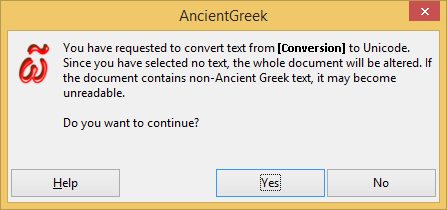Ismini Encoding
Ismini is a method of representing, characters found in ancient Greek texts using ASCII characters.
It is based on the Ismini font, copyrighted by N. Goulandris, 1986-1993 and published by Altsys Metamorphosis: 20/03/1994, as a freeware package.
Download Ismini font ^
You will have to download the Ismini font in case
- You want to be able to read Ismini encoded text without converting it to Unicode
- You want to publish Ismini encoded documents or web pages
AncientGreek Ismini conversion Macros ^
I suggest saving your work before running either of these macros on a document (no text selection), so that reverting (Menu File / Reload) to it is possible, as Undoing may not be of much help, since a letter by letter substitution will take place resulting in way too many undo steps.
If any of these macros are executed without selecting any text, a warning message similar to the one shown in the following picture will appear.

Warning message on Windows 8.1
• IsminiToUnicode Macro
This macro converts text written in Ismini to Unicode (normal text that can be edited in LibreOffice / OpenOffice).
• UnicodeToIsmini Macro
This macro converts text written in Unicode (normal text edited in LibreOffice / OpenOffice) to Ismini.
Using fullwidth characters ^
If the document (or selection) contains ASCII characters (English text), they will automatically be converted to the "fullwidth / halfwidth" characters, when text conversion from Unicode to Ismini is performed.
Ismini implementation ^
AncientGreek fully implements the encoding as shown in the following table.
| Greek Letter | ASCII Character | Greek Letter | ASCII Character |
|---|---|---|---|
| Alpha | A | Nu | N |
| Beta | B | Xi | J |
| Gamma | G | Omicron | O |
| Delta | D | Pi | P |
| Epsilon | E | Rho | R |
| Zeta | Z | Sigma | S |
| Eta | H | Tau | T |
| Theta | U | Upsilon | Y |
| Iota | I | Phi | F |
| Kappa | K | Chi | X |
| Lambda | L | Psi | C |
| Mu | M | Omega | V |
| Diacritics | |||
| Smooth breathing (᾿) | | | Period (.) | . |
| Rough breathing (῾) | \ | Comma (,) | , |
| Acute (´) | ´ | Grave (`) | ` |
| Ano teleia (·) | ? | Greek Middle Dot (·) | – |
| Circumflex (῀) | ^ | Greek Question Mark (;) | ; |
| Iota subscript (ι) | $ | Hyphen (-) | _ |
| Smooth breathing with Acute (῎) |
= | Rough breathing with Acute (῞) |
+ |
| Smooth breathing with Grave (῍) |
ù | Rough breathing with Grave (῝) |
% |
| Smooth breathing with Circumflex (῏) |
≠ | Rough breathing with Circumflex (῟) |
± |
| Stand-alone characters | |||
| ὤ | ~ | ᾦ | ÷ |
| ἴ | ¬ | ἶ | µ |
| ὥ | ¯ | ῖ | ¡ |
| ὦ | ¿ | ἁ | · |
| ἔ | ‘ | ἕ | ’ |
| ἄ | “ | ἅ | ” |
| ὖ | « | ὗ | » |
| ἒ | [ | ὂ | ] |
| ὔ | { | ἲ | } |
| ῶ | © | ἐ | ® |
| ὃ | ¤ | ὒ | ¢ |
| ὲ | ‚ | ἑ | „ |
| ῦ | † | ἳ | ‡ |
| ἂ | • | ὕ | ‹ |
| ῆ | ∂ | ἠ | ∆ |
| ὁ | ∏ | ἓ | ∕ |
| ῒ | ∞ | ὠ | ∫ |
| ὼ | ◊ | ἱ | (U+F000) * |
| ῢ | (U+F002) * | ἦ | ƒ |
| ἰ | ʺ | ῷ | ˆ |
| ᾣ | ˇ | ὧ | ˘ |
| ᾶ | ˙ | ἤ | ˚ |
| ᾢ | ˛ | ὡ | ˜ |
| ᾅ | á | ὶ | Á |
| ᾡ | À | ᾆ | â |
| ὺ | Â | ὰ | Å |
| ᾇ | ä | ᾴ | Ä |
| ᾂ | ã | ᾤ | Ã |
| ὐ | ª | ὢ | æ |
| ὣ | Æ | ά | å |
| ΐ | Ç | ᾲ | É |
| ᾷ | È | ᾃ | ê |
| ὑ | Ê | ῃ | ë |
| ὓ | Ë | Ϊ | è |
| Ϋ | é | ⨯ | I |
| ῄ | í | ἇ | Í |
| ῂ | ì | ἥ | Ì |
| ᾐ | î | ῇ | Î |
| ᾑ | ï | ἧ | Ï |
| ᾔ | ñ | ᾀ | Ñ |
| ᾕ | ó | ὴ | Ó |
| ᾖ | ò | ἵ | Ò |
| ᾗ | ô | ἡ | Ô |
| ᾒ | ö | ᾁ | Ö |
| ᾓ | õ | ᾥ | Õ |
| ὸ | Ø | ὄ | œ |
| ὅ | Œ | ί | º |
| ό | ø | ᾳ | Q |
| ς | q | ἆ | ß |
| ῴ | ú | ἷ | Ú |
| ἣ | Ù | ῲ | û |
| ῳ | Û | ᾠ | ü |
| ᾄ | Ü | V | ≈ |
| ῤ | w | ῥ | W |
| ᾧ | ÿ | ἃ | Ÿ |
| έ | ™ | ή | ¸ |
| ϊ | › | ὀ | π |
| ἢ | Σ | ύ | ¥ |
| ϋ | ‰ | ΰ | (U+F001) * |
| ἀ | Ω | ώ | √ |
| Other characters | |||
| Vertical Line (|) | — | Dagger (†) | £ |
| Left Square Bracket ([) | ≤ | Right Square Bracket (]) | ≥ |
| Left Curly Bracket ({) |
ç | Right Curly Bracket (}) | à |
* PUA code point
Note
Capital letters with diacritics are inserted using stand-alone diacritics followed by a capital letter. For example capital alpha with grave (Ὰ) is inserted as `A, capital rho with rough breathing (Ῥ) is inserted as \R, etc.

